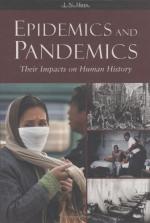|
This section contains 1,691 words (approx. 6 pages at 300 words per page) |

|
anthrax: A bacterium-caused infectious disease that usually affects sheep and cattle but can be fatal to humans; it is a likely choice for use in biological warfare.
antibiotic: A drug that kills bacteria or stops their activity.
antibodies: Defensive mechanism produced by the immune system in response to invasion by microorganisms or other foreign substances; a different type of antibody is produced for each type of microorganism.
bacteria (plural of bacterium): Single-celled microorganisms, some of which can cause disease when they invade the body.
Biological Weapons Convention: A treaty prohibiting the use or stockpiling of biological weapons, first established in 1972.
BL-4: Biocontainment Level 4, the level of laboratory security required for handling microorganisms that cause fatal human diseases for which there is no treatment or vaccine.
Black Death: Bubonic plague; specifically, the plague pandemic that struck Europe in 1347.
blue suit: The space-suit-like protective clothing that workers in a BL-...
|
This section contains 1,691 words (approx. 6 pages at 300 words per page) |

|




